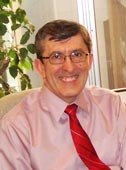Wayne Johnston Elected President of the Society of Vascular Surgeons

Wayne Johnston
|
Vascular surgeon Wayne Johnston is capping his distinguished career as President
of the Society of Vascular Surgeons - the first Canadian in the 62-year history
of the Society. He has had many distinguished contributions and honours. He has
served as Editor in Chief of the Journal of Vascular Surgery, Founding Editor of
Vascular Specialist, Founding Editor of VascularWeb, Associate Editor for four editions
of Rutherford's Textbook of Vascular Surgery, the reference standard in the field,
and now is Co-editor for the next edition.
Wayne has served the Department of Surgery as Chair of the Vascular Surgery Division
for two decades, Associate Chair, and as Committee Chair for the Promotions Committee,
Finance Committee, and 3-year Review Committee. He has served many outside agencies
including Chair of the Medical Research Council Clinician Scientist Committee and
Chair of the Royal College Nucleus Committee for Vascular Surgery.
He holds the R. Fraser Elliott Chair in Vascular Surgery. He maintained continuous
CIHR or Medical Research Council funding for his research with Professor Richard
Cobbold from Biomedical Engineering for 30 years. He became interested in non-invasive
diagnostic testing and biomedical engineering during his research fellowship at
King's College Hospital and established one of the first non-invasive diagnostic
laboratories in North America. He has been recipient of the Department's Lister
Prize for Surgical Research.
A Silver Medalist Graduate of the University of Toronto, Faculty of Medicine, he
completed his general surgery and vascular training in Toronto and additional vascular
fellowship at King's College in London, England. Wayne has a fascinating perspective
on the evolution of vascular surgery and vascular surgery organizations. He chaired
the Merger Committee when the American Association for Vascular Surgery joined the
previously restricted academically elite Society of Vascular Surgeons. He helped
overcome resistance to the merger by creating the category of Distinguished Fellow
within the SVS to recognize those members who made major contributions to education,
research and practice.
The highlight of his personal continuing education has been a James IV Traveling
Fellowship, where he had the opportunity to think critically and reflectively about
other ways of approaching the practice of medicine. Also, to further his own experience,
he has been grateful to have been invited to visit numerous other universities as
a lecturer and has been honoured by giving more than 10 named lectureships.
|
He led the field of vascular surgery in the performance of complex open procedures
as well as vascular laboratory diagnostics and was among the first to introduce
peripheral vascular angioplasty. Wayne's clinical study of the role of peripheral
angioplasty in the early 1980s and report the world's largest prospective series
of 997 well-studied patients was a major factor in the wide application of this
technique. (In an echo of Y2K, his Hewlett-Packard '85 computer could not take 1000
entries into its matrix.) His trans-Canada prospective series of elective and ruptured
abdominal aneurysms (887 patients operated upon by 72 surgeons during 9 months)
remains the world's largest prospective detailed study and at the time established
benchmarks for the surgical treatment of this problem.
In his role as an officer and active participant in organized vascular surgery,
he has seen dramatic changes in the specialty. During the last decade, less invasive
procedures, angioplasty, and stents have become an increasingly significant part
of the practice of a vascular surgeon. There is some confusion among practitioners
during this decade of change but in most centers the advanced endovascular skills
of vascular surgeons have become clearly redefined. Interestingly, in the society
of vascular surgery, the participation of practitioners on committees and work groups
is at a high level, 240 members of the 2400 member society are actively engaged
in committee and council work. This may reflect practitioners' need to be connected
and informed in a period of dynamic change.
Wayne spends one or two full days per week or more helping to manage the Society
of Vascular Surgeons or traveling on its behalf. On the day that I interviewed him,
he had two ninety-minute conference calls scheduled for 5 and 8 p.m. and several
hours' preparation to be sure they were effective. He learned his management skills
through experience at the University of Toronto and by attending executive courses
for professionals and volunteers to strengthen their skills in managing boards and
working with administrative staff.
Wayne enjoys gardening, photography and is a devoted fan of Formula One auto racing.
His son Matthew lives in Hong Kong and is VP for strategic planning for Asia for
an international investment bank. His daughter Andrea has had a 10-year career as
a professional modern dancer in New York City and continues dancing professionally
along with a new position as an Occupational Therapist at Mount Sinai Hospital in
New York. His wife of 40 years, Jean, is a neurologist and specialist in electrophysiology
at St. Michael's Hospital.
He has had many mentors and collaborators throughout his career. He particularly
remembers the major contributions of Bernie Langer, Bruce Tovee, Don Wilson, and
Ron Baird. Professor Richard Cobbold in Biomedical Engineering has been a research
collaborator for more than 30 years. He has enjoyed all aspects of his academic
career but in particular patient care, resident teaching, graduate student supervision,
and research.
M.M.
|